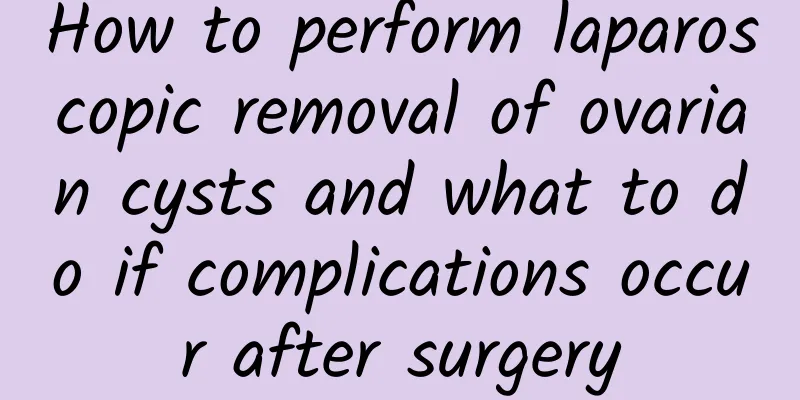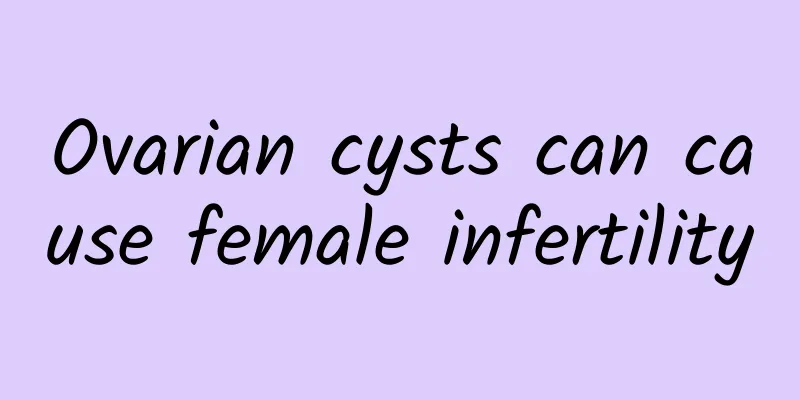How to perform laparoscopic removal of ovarian cysts and what to do if complications occur after surgery

|
How to perform laparoscopic ovarian cystectomy? What to do about postoperative complications? Laparoscopy is a method of opening the uterine cavity through a fiber-optic light beam and lens. A cold light source is passed through the hysteroscope into the uterine cavity, and the lower cervical canal, uterine os, endometrium and fallopian tube opening are directly observed to examine and diagnose the physiological and pathological conditions of the uterine cavity. Corresponding treatments can also be performed at the same time. It is more intuitive, accurate and reliable than traditional methods such as curettage and B-ultrasound in understanding the images within the uterine cavity, and samples can be taken more accurately for pathological examination. Surgical treatments within the uterine cavity can also be performed by directly viewing the cavity. There are many laparoscopic methods for treating ovarian cysts, including removing cysts, preserving ovaries, releasing cystic fluid, destroying cyst walls, perforating polycystic ovaries, and removing adnexa when necessary. The nursing care for laparoscopic complications after ovarian cyst surgery is as follows: 1. Abdominal distension. Used during surgery. CO2 weakens intestinal peristalsis and generally does not require treatment. If there is obvious abdominal distension and no gas is passed after 48 hours, it should be discharged through the rectal tube, or 0.5 mg of Neosat can be injected intramuscularly to promote intestinal peristalsis. 2. Subcutaneous emphysema is often related to the failure of the pneumoperitoneum needle to enter the abdominal cavity, excessive pneumoperitoneum pressure during surgery, excessive incision, or severe pelvic adhesions. It manifests as a feeling of distortion and there is no need to treat mild subcutaneous emphysema at the same time. 3. Replace the bleeding dressing at the puncture site promptly. 4. Pay attention to abdominal signs such as abdominal distension, abdominal pain, and shifting dullness. Notify the attending physician promptly. If there is a small amount of bleeding, apply pressure bandage. If there is a large amount of hematoma, the bleeding point should be removed. 5. In case of hypercapnia, oxygen should be administered after surgery, electrolytes and blood gas analysis should be checked, and acidosis should be corrected if necessary. |
>>: Do uterine fibroids require surgery?
Recommend
Is subserosal uterine fibroid a benign tumor? Does subserosal uterine fibroid have any effect on conception?
Among gynecological diseases, uterine fibroids ar...
There are several reasons for the sequelae of pelvic inflammatory disease
We are all familiar with diseases. As we all know...
How much does an abortion cost?
The cost of an abortion varies depending on many ...
What you need to know about the prevention of uterine fibroids
The occurrence of uterine fibroids seriously thre...
What are the main causes of adnexitis?
What are the main causes of adnexitis? I believe ...
What is the reason for three menstrual periods in a month?
What is the reason for three menstrual periods in...
What are the warning signs of irregular menstruation?
What are the danger signs of irregular menstruati...
What to do if ovarian cysts recur
What should I do if ovarian cysts recur? Ovarian ...
Why do people often bleed after abortion?
Why do people often bleed after abortion? Frequen...
Is it better to exercise during menstruation?
Whether to exercise during menstruation depends o...
What foods are good for cervical warts
The incidence of cervical warts is very high in m...
Eat pork trotter with Luoshixian? Psyllium for diarrhea relief
The Chinese New Year is approaching. Every year b...
What are the symptoms of pelvic inflammatory disease in women
Female pelvic inflammatory disease generally has ...
Can cervical erosion develop into cervical cancer?
"Cervical erosion" troubles many female...
Does a big waist and a bloated belly mean a short life? The new three measurements for health: waist, hips, and calf circumference
With a bloated "water bucket waist", be...









